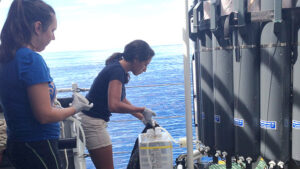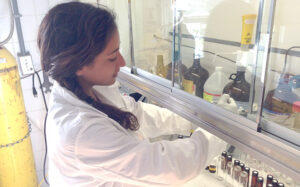REU Student Presents at Aquatic Sciences Meeting

When Esra Mescioglu learned she was accepted to the Fall 2013 Research Experiences for Undergraduates (REU) program at BIOS, she didn’t know what to expect. Frankly, she was a little nervous to leave behind her friends and routine at the University of Massachusetts in Boston. Now, more than a year after her internship in Bermuda, she is thankful her nerves didn’t deter her and is flying from one scientific adventure to the next. Last week Mescioglu is presenting the results of her research project at the Aquatic Sciences meeting of the American Society for Limnology and Oceanography (ASLO) in Granada, Spain, and is quick to share how valuable her experience in the BIOS REU program was.
From Organic Matter to Microbes
As an undergraduate in Boston, Mescioglu had helped with a study tracking chromophoric (light-absorbing) dissolved organic matter (CDOM) in saltmarshes, and had also used DNA to study the evolutionary relationships among spiders and arthropods. “I’d been involved in molecular biology, but I’d never had the chance to work with microbes,” said Mescioglu, who was curious about how molecular biology can reveal microbial communities and processes.
Thus, for her REU at BIOS Mescioglu approached scientist Natasha McDonald, a photochemist whose research traces the path of CDOM throughout the ocean, about an ongoing project in her lab studying lignin in the open ocean. Lignin is one variety of organic matter that originates from the stiff cell walls of wood; on land, a few species of fungi and bacteria are known to be capable of slowly breaking down lignin in soil. As rivers flow to the sea, they carry organic matter to coastal and open waters. Thus, while lignin is created on land, it is ubiquitously present in marine environments.
Mescioglu’s interest in microbial communities led them to microbial oceanographer and REU program director Rachel Parsons, who has years of experience discovering the identities and contributions of the ocean’s diverse and relatively unknown bacteria and archea. Parsons agreed to teach Mescioglu methods to quantify change in microbial community abundance and composition.
Together, they designed a series of experiments to discover whether marine microbial communities could grow using dissolved lignin as their primary source of nutrients. Using seawater samples she collected at the well-studied BATS site, Mescioglu set up a series of incubation experiments designed to test the growth of the naturally occurring microbial community. The experiments included seawater with lignin added to it, a negative control where nothing was added to the nutrient-poor seawater, and a positive control where a veritable buffet of easily digested glucose, nitrogen and phosphate should produce robust growth of known bacteria.
Over eight days, Mescioglu took samples every 12 hours to quantify the amount of CDOM and analyze concurrent changes in the microbial community. She learned how to count bacteria and archaea using epifluorescent microscopy and Fluorescent in-situ Hybridization (FISH) to identify whether commonly abundant bacterial groups were increasing or decreasing in the samples over time. She also used Catalyzed Reporter Deposition FISH to determine the proportion of archaea within her samples.

The Highs and Lows of Doing Science
Not everything went as planned. On the cruise to collect samples at the BATS site, Mescioglu discovered she had a terrible predisposition to seasickness. Experiments failed, methods evolved, and equipment broke. “Hands-on science” took on new meaning when the spectrometer – critical for reading CDOM concentrations in the samples – broke and McDonald taught Mescioglu how to solder it back together.
“I was a little shocked,” Mescioglu said, “To realize, this is what science is really like? But our first experiment generated some cool results, and that got us excited to do it again, a little differently. In the end we generated a great dataset.”
“Esra is a quintessential example of the reason I like mentoring REU students,” said McDonald. “She came to BIOS as an incredibly intelligent student who already had some experience with lab work. Most importantly, she had a genuine excitement about conducting scientific research and exploring novel ideas.”
The results from the experiment suggest the addition of lignin spurred bacterial growth, including the growth of some known groups like SAR11 and Crenarcheota. Since SAR11 and Crenarcheota are slow growers, the growth on lignin was not as fast or immediate as the growth of bacteria in the seawater amended with glucose. However, their growth within two days of the lignin addition is a surprising contrast to previous estimates that lignin requires years to be degraded. Furthermore, a spike in CDOM concentration followed shortly after the spike in bacterial population, suggesting lignin was broken down to produce more CDOM.
“Of course we still don’t know exactly how the lignin is broken down,” said Parsons, “but it’s just fascinating that out in the middle of the open ocean, you can add lignin and open ocean bacteria can use this terrestrial source of carbon for growth.”
Taking the Next Step
Mescioglu tells potential REU applicants that the opportunity to work within a supportive community of students and mentors is invaluable, and her best advice is that you’ll never get in if you don’t apply. “Not only do you get paid to be a real scientist for three months,” said Mescioglu. “I got to live with seven other awesome, open-minded people interested in science. And Bermuda is such a beautiful, pristine place. It was some of the best months I’ve ever had.”
McDonald is firm in her belief that REU interns are not there to work mindlessly, and should develop tangible scientific skills from the REU experience. “By learning new techniques, polishing lab skills and proficiency at experimental design, scientific writing and presentation — this internship should help them develop and refine those crucial bits to prepare them for a career in science.”
After she graduates from the University of Massachusetts in Boston this spring, Mescioglu will embark on the next step of her career in a graduate program in microbiology. McDonald couldn’t be happier, but also jokes she’s jealous of Mescioglu’s new advisor, who will get to supervise such a great student!
For more information on the REU program or to apply visit the REU webpage.
Read more about the REU program from the 2014 student blogs.
